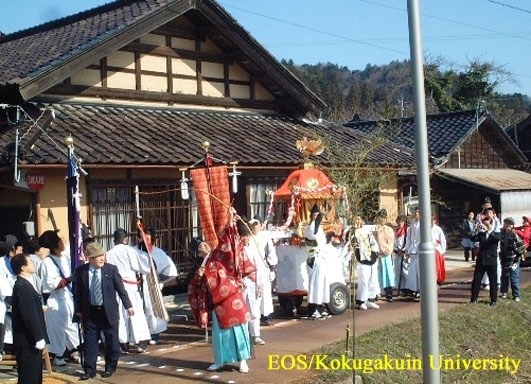- トップ
- Encyclopedia of Shinto
- Kunimuke matsuri
Encyclopedia of Shinto
| Main Menu: | |
| Links: |
詳細表示 (Complete Article)
| カテゴリー1: | 5. Rites and Festivals |
|---|---|
| カテゴリー2: | Individual Shrine Observances |
| Title | Kunimuke matsuri |
| Text | A shinkōsai (processional festival) held from March 18 to 23 at Keta Jinja, Hakui City, Ishikawa Prefecture. The festival name is also read heikokusai. It is a rite that recollects the territorial pacification exploits of the saijin (main enshrined kami) Ōnamuchinomikoto. A grand procession with a shinme (a horse upon which the kami rides) at the head makes a round trip from Keta Shrine to Ikukunitamahiko Shrine in Nanao City, a trip of a hundred and several tens of kilometers lasting five nights and six days. It is said that spring comes to the Noto region with this festival. Although in former times this used to be a rite in which a shin'yo (sacred palanquin) processed around the entire province, it is now limited to the counties of Hakui and Kajima. In the procession the shinme is in the lead, with long-handled scythes, shrine name flags, rice chests, standards, shishinboko (four-kami pikes), bows and arrows, kunimuke hiroboko (wide-bladed kunimuke halberds), and mounted priests in front and behind, protecting the shin'yo. On the first day it travels around the northern area of Hakui County, stopping at Takiya Shrine in Hakui Town. On the second day, the procession moves around the southern area and stops over night at the Inoyama Shrine in Inoyama Town. On the third day it enters Kajima District and proceeds to the Noto Ikukunitamahiko Shrine. This is another name for Keta Jingū and is regarded as its original shrine. When the shin'yo enters the shrine the people who have been accompanying it raise a shout and pour into the shrine precincts (keidai). The mounted priests proceed into the grounds as well. However, in recent years, it is said that if they fall off their horses there will be an abundant harvest, so it has become quite wild. On the fourth day they begin their return journey from Nanao to Kajima County, stopping at Shirahiko Shrine in Toriya Town. On the fifth day they pass through the towns in the Noto area on their return to the main shrine (honsha). This is also called the oide matsuri (Departure Festival). The shin'yo is enshrined in the haiden (worship hall) until the Oisumi reisai (annual festival) on April 3. Another name for this (latter) festival is the Eye of the Snake Rite (Ja no me shinji) in which a snake eye target representing the great serpent that Ōnamuchinomikoto vanquished is destroyed with long swords, halberds and bows and arrows. There is a kunimuke festival on May 21 at Hiraoka Jinja in Higashi Osaka City, Osaka Prefecture. In addition to the main ritual observance, at present the priests merely wave and offer halberds to the kami. The rite is said to originate in the myth relating the occasion of Nagasunehiko's prevention of Emperor Jinmu's eastern movement over Ikoma Mountain during the latter's pacification campaign of the Yamato region. Formerly there was a ceremonial event in which participants went into the mountains in the evening to collect wood. Then they ran around striking the shrine buildings and the worship hall with the collected wood before returning home. In pre-modern times this occurred on February 1, but was abolished with the Meiji Resoration. It was revived in the seventh year of the Taishō era (1918), and since then has been observed on the present festival day. — Mogi Sakae |




